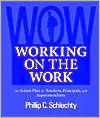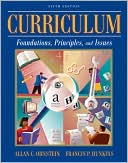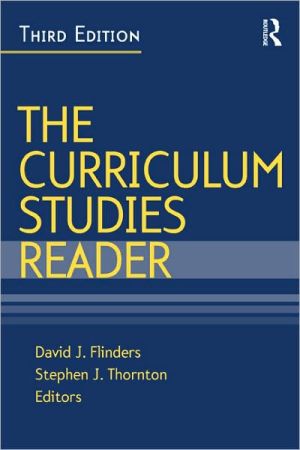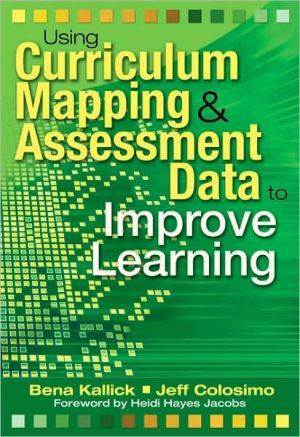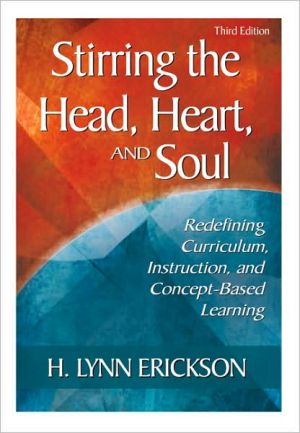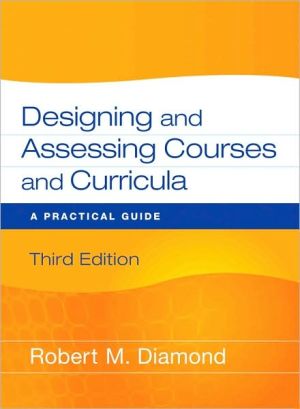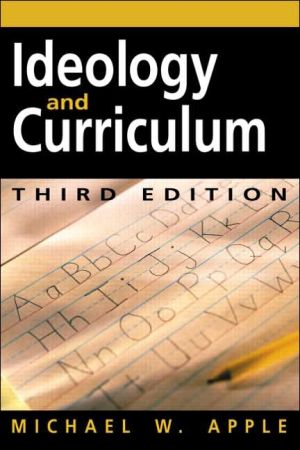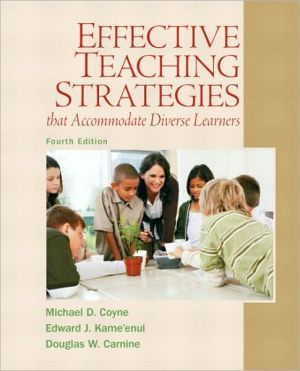Working on the Work: An Action Plan for Teachers, Principals, and Superintendents
"Authentic student engagement in meaningful classroom work is the key to accountability. If teachers work-on-the-work, accountability will take care of itself. Thanks, Phil Schlecthy, for illuminating the way for all concerned educators and parents." —Lawrence W. Lezotte, educational consultant and commentator, and author, Learning for All, The Effective Schools Process\ "Schlechty takes everything he knows about education, places it in a user-friendly format, and delivers it to the...
Search in google:
If student performance is to be improved, says Phillip Schlechty, there are at least three ways to approach the problem: 1) work on the students, 2) work on the teachers, or 3) work on the work. Unfortunately, the first two have thus far produced unimpressive results. The key to improving education, Schlechty believes, lies in the third alternative: to provide better quality work for students-work that is engaging and that enables students to learn what they need in order to succeed in the world. In this practical companion to the author's popular books Shaking Up the Schoolhouse and Inventing Better Schools, Schlechty, one of America's most renowned school reformers, presents the Working on the Work (WOW) framework-an outline for improving student performance by improving the quality of schoolwork. Field-tested in schools across the country, the WOW framework describes the twelve essential components of a WOW school and suggests ways to improve the quality of content, organization of knowledge, measurement of achievement, nurturance of creativity, and novelty and variety of tasks. Schlechty offers practical guidelines for redesigning classroom activity so that more students are highly engaged in schoolwork, developing clear and compelling standards for assessing student work, and making clear connections between what students are doing and what they are expected to produce. He also discusses the roles of teachers, principals, and superintendents-and how they individually and collectively play a part in the WOW process. The book's appendixes include useful questionnaires that will facilitate discussion, analysis, and action planning at both school and classroom levels. Superintendents can use these tools to help principals and teachers to create a vision of schools where all students are engaged in important work. Principals can assess how well their schools are serving their students. And teachers can use the questionnaires to better understand what is really going on in their classrooms and what actions are likely to increase the authentic engagement of students. Booknews Schlechty argues that the secret to improving student performance is providing better quality work for students. He provides a framework for providing work which is engaging, and details the roles of teaches, principals, and superintendents. He suggests ways to improve the content of lessons, the organization of knowledge, the measurements of achievement, the nurturance of creativity, and the variety of tasks. He proposes practical guidelines for classroom activity and standards of evaluation. Schlechty is affiliated with the Center for Leadership in School Reform. Annotation c. Book News, Inc., Portland, OR (booknews.com)
Working on the Work\ An Action Plan for Teachers, Principals, and Superintendents \ \ By Phillip C. Schlechty \ John Wiley & Sons\ ISBN: 0-7879-6165-5 \ \ \ Chapter One\ Making Engagement Central \ If students become engaged in the right "stuff," they are likely to learn what we want them to learn.\ In Shaking Up the Schoolhouse (Schlechty, 2000), I distinguish among five types of responses students might make to any school task (see Figure 1.1):\ Authentic engagement. The task, activity, or work the student is assigned or encouraged to undertake is associated with a result or outcome that has clear meaning and relatively immediate value to the student-for example, reading a book on a topic of personal interest to the student or to get access to information that the student needs to solve a problem of real interest to him or her.\ * Ritual engagement. The immediate end of the assigned work has little or no inherent meaning or direct value to the student, but the student associates it with extrinsic outcomes and results that are of value-for example, reading a book in order to pass a test or to earn grades needed to be accepted at college. * Passive compliance. The student is willing to expend whatever effort is needed to avoid negative consequences, although he or she sees little meaning in the tasks assigned or the consequences of doing those tasks.\ * Retreatism. The student is disengaged from the tasks,expends no energy in attempting to comply with the demands of the tasks, but does not act in ways that disrupt others and does not try to substitute other activities for the assigned task.\ * Rebellion. The student summarily refuses to do the task assigned, acts in ways that disrupt others, or attempts to substitute tasks and activities to which he or she is committed in lieu of those assigned or supported by the school and by the teacher.\ Given this typology, it becomes possible to characterize classrooms in terms of the patterns of engagement that are observed. These characterizations are based on the following assumptions:\ Any given student will be engaged in different ways in different tasks, and sometimes this engagement will differ with regard to the same task. For example, a student who normally finds a task authentically engaging may resort to retreatism on a given day or at a given moment simply because he or she is tired or distracted by other concerns. Sometimes the same student may be passively compliant, and at other times the only thing that is compelling about the task is what its accomplishment makes possible in another arena (perhaps eligibility to play football). The issue is not the presence or absence of these different forms of engagement but the pattern these forms create over time.\ Retreatism, passive compliance, and ritual engagement are not in themselves indicators of pathology in the classroom. Furthermore, a student who is ritually engaged or passively compliant or in a retreatist mode is not necessarily "misbehaving." In fact, it is not at all clear that anyone could tolerate-emotionally and physically-being engaged authentically all the time. Retreatism may be a resting point for a student who has otherwise been authentically engaged throughout the activity.\ As schools are now organized, student success, especially success in doing well in an environment that places emphasis on high test scores, does not require authentic engagement. In fact, many of the strategies that are being advanced to improve test scores are nothing more or less than efforts to increase passive compliance and ritual engagement and decrease retreatism and rebellion.\ Each of the types of engagement represents a different type or category of response rather than a different point on a continuum. A student who is ritually engaged is engaged in a different way than is a student who is authentically engaged. Those who are ritually engaged are not necessarily less engaged than are those who are authentically engaged; they are engaged for a different reason or set of reasons. Similarly, passive compliance is a distinct type of engagement. Unlike either authentic engagement or ritual engagement, however, passive compliance is likely to be motivated more by avoidance of punishment or unpleasant consequences than by any type of positive goal or outcome.\ * It is assumed that different types of engagement produce different types of commitment and, therefore, different types of effort and learning results. Here it is important to note that I proceed from the hunch-and at this point it is nothing more than a hunch-that students who are ritually engaged do learn what they need to learn to do well on tests and satisfy the demands of adult authority, although they probably retain less of what they have "learned" than would be the case if they were authentically engaged. Indeed, students who are ritually engaged are likely to be so concerned with what is going to be on the test that they will be reluctant to undertake any task that does not have some clear payoff in terms of extrinsic values associated with such performance measures.\ THE HIGHLY ENGAGED CLASSROOM\ In the highly engaged classroom, most students are authentically engaged most of the time (see Figure 1.2). There are also, however, considerable ritual engagement, some passive compliance, and maybe even a limited amount of retreatism. Rebellion may also occur in the highly engaged classroom, but it will be idiosyncratic and will not be sustained long enough to be patterned. In summary, most students in the highly engaged classroom are authentically engaged most of the time, and all students are authentically engaged some of the time. It is also a classroom that has little or no rebellion, limited retreatism, and limited passive compliance.\ THE WELL-MANAGED CLASSROOM\ The well-managed classroom has considerably less authentic engagement than does the highly engaged classroom (see Figure 1.3). It also has considerably more passive compliance and retreatism. Ritual engagement, as opposed to authentic engagement, is the dominant mode of response in the well-managed classroom. As in the highly engaged classroom, there is little or no rebellion.\ Because such a classroom is orderly and most students seem to do the work assigned -some with a degree of enthusiasm-it is easy for the teacher and the outside observer to confuse the well-managed classroom with the highly engaged classroom. The well-managed classroom appears well managed not because students are authentically engaged but because they are willing to be compliant. As long as the teacher and the principal fail to ask the right questions of students, the absence of authentic engagement will probably go unnoticed, though the effects on learning may be quite real. (See, for example, Pope, 2001.)\ THE PATHOLOGICAL CLASSROOM\ The pathological classroom looks very much like the well-managed classroom except for the presence of patterned rebellion (see Figure 1.4). The rebellion is not limited to isolated cases. Many students actively reject the task assigned or substitute other activity to replace what has been officially assigned or expected. (Cheating is a form of rebellion too.)\ Furthermore, it seems likely that in the effort to reduce rebellion, teachers in the pathological classroom often settle for retreatism or passive compliance and "work on the students" to gain such a response. Indeed, although I have no empirical evidence on which to base my hunch, I would bet that teachers in pathological classrooms tend to lower performance expectations to the point that passive compliance gets higher rewards (better grades) than would be produced in a highly engaged classroom. This could be one source of the grade inflation that is of such concern to some critics of public schools.\ Nevertheless, there is likely to be some degree of authentic engagement even in the pathological classroom. For example, the subject being taught may be of such interest to a particular student that he or she finds meaning in the tasks even when the tasks are poorly designed.\ There is likely to be considerable ritual engagement as well; some students need the grade to get into college, or they so fear displeasing their parents that they do whatever they need to do to get the teacher's approval. The incidence of passive compliance will also be high, as will be the incidence of retreatism. Indeed, it is the increase in retreatism and the presence of patterns of rebellion that distinguish the pathological classroom from the well-managed classroom.\ DEVELOPING AN ENGAGEMENT PROFILE\ One of the first steps in moving toward continuously improving the quality of the work provided to students is to center attention on the patterns of engagement in a classroom or set of classrooms. An individual teacher operating alone can do much to understand better what is going on in his or her classroom. For example, using the rubrics provided later in this chapter as a guide, teachers can develop a profile of their own classroom, whether or not the principal or the colleagues join them. I have found, however, that leadership by a principal and support from colleagues increase the likelihood that teachers will stick with the process long enough to make it a routine part of their school lives.\ There are a variety of ways to generate the energy needed to sustain a group effort. One that I have observed to work well includes beginning with an "all-hands" workshop where the faculty is made aware of the basic ideas underlying the WOW model. Following the initial workshop, principals are encouraged to work with volunteer teachers to develop an engagement profile for the school.\ At the same time, volunteer teachers are encouraged to develop profiles of their own classroom along the lines suggested by Figures 1.1 through 1.4. By making comparisons between two points in time (say, week 1 compared to week 2), teachers are able to see, in graphic terms, how patterns of engagement in their classroom vary from day to day and task to task. As teachers begin to see such variance, they begin to ask why this is so. Most teachers already understand, intuitively at least, that the nature of the work they assign to students has a considerable bearing on this matter. Initially, however, some teachers may seek explanations in such factors as the time of day, the day of the week, and maybe even the sign of the moon. Eventually, most teachers come to embrace the notion that the tasks that they assign to students are one of the few variables under their control that directly affect student engagement. It is at this point that the WOW framework begins to make real sense to teachers. When they come to believe that they can make a direct and immediate difference in something they care about (and they do care about student engagement), they have a reason to work on the work.\ A BEGINNING POINT FOR MEASUREMENT\ Efforts to measure student engagement are just beginning. The Center for Leadership in School Reform (CLSR), a nonprofit corporation I founded in 1988, has recently engaged in a partnership arrangement with software development firm Tetra-Data that is intended to create ways of collecting and managing data relevant to engagement that will be unobtrusive, require little additional teacher effort, and be easy to manage and analyze. However, no standard measures exist now. Therefore, principals and teachers, while taking advantage of what is provided here, need to be prepared to create their own measures. The following observations are important as foreground to this creative effort:\ Each of the five types of engagement should be treated as a discreet category rather than a point on a continuum. For example, it should not be assumed that the student who is authentically engaged in the task assigned is more engaged than the student who is ritually engaged. The authentically engaged student is simply engaged in a different way. Similarly, the passively compliant student is not less engaged than the ritually engaged, even though passive compliance is likely to produce less effort than is either ritual engagement or authentic engagement.8 Retreatism is really a form of disengagement, which is categorically different from engagement.\ Rebellion is-or may be-a form of engagement, but the focus of the engagement may be at odds with that which is needed if the student is to learn what it is intended he or she learn. The student who cheats on a test, for example, may be authentically engaged in doing what is needed to get a good grade but rejects completely the requirements of the tasks he or she needs to complete to accomplish this end by legitimate means.\ RUBRICS\ Rubrics are often useful in developing ways of measuring social phenomena. The five rubrics that follow can serve as frameworks for teachers and principals who are working toward developing ways of assessing student engagement:\ Authentic engagement. Authentically engaged students see meaning in what they are doing, and that meaning is connected to ends or results that truly matter to the students. Indeed, these authentically engaged students may be willing to do some boring and otherwise meaningless tasks, precisely because they see the linkage between what is being done and some task-related end of significant consequence to them. For example, students who want to become musicians regularly practice scales (not a particularly exciting task) because they see such practice as a means of achieving the end they have in view.\ The critical point is that when students are authentically engaged, the distinction between ends and means becomes blurred. What in another context they would consider trivial and meaningless becomes loaded with meaning and significance to those who are authentically engaged. Thus, the student who diligently proofreads his or her paper to ensure that the grammar and punctuation are correct because he or she takes pride in being a good writer is engaged in a different way from the student who does such checking only "when it counts for a grade."\ Ritual engagement. This form of engagement is typified by the separation of means from ends. Students do the work and carry out the tasks, sometimes with diligence and persistence, but they do so for reasons that are disassociated from the task itself. The end toward which the task is directed (such as the production of a good work product) is unimportant to the student. What is important is the impact the successful completion of the task will have on other areas of school life or on the student's personal life. Thus a student who is bent on being admitted to a highly selective college is more likely to be concerned with the grade she or he receives in the course than with whatever learning must be done to attain that grade.\ \ Continues...\ \ \ \ Excerpted from Working on the Work by Phillip C. Schlechty Excerpted by permission.\ All rights reserved. No part of this excerpt may be reproduced or reprinted without permission in writing from the publisher.\ Excerpts are provided by Dial-A-Book Inc. solely for the personal use of visitors to this web site. \ \
Chapter 1.Introduction.The Basic Theme.Schoolwork: A Commonplace Term.On the Nature of Schoolwork.The Research Base.Basic Assumptions.The Role of the Teacher.Facilitator, Coach, or Leader?Leaders Must Lead.Competence and Commitment.The Importance of Discipline.Engaging Work and Engaging Teachers.Organization of the Book.Chapter 2.Making Engagement Central.The Highly Engaged Classroom.The Well-Managed Classroom.The Pathological Classroom.Developing an Engagement Profile.A Beginning Point for Measurement.Rubics.Getting Relevant Data.A Caution.Chapter 3.The WOW School.Thinking Strategically.Identifying Missions.The WOW School: A Vision.Framing the Dialogue.Patterns of Engagement.Student Achievement.Content and Substance.Organization of Knowledge.Product Focus.Clear and Compelling Standards.Protection from Adverse Consequence.Affirmation of Performances.Affiliation.Novelty and Variety.Choice.Authenticity.Starting the Conversation.Some Concluding Observations.The Issue of Time.Chapter 4:Implications for Teachers.Understanding, Assessment, Control, and Improvement.What Can Teachers Control?Knowing and Teaching the "Right Stuff".Focus on Engagement.Work on the Work.Thinking As a Leader.Top Down and Bottom Up.Consulting with Parents.Chapter 5.The Principal's Role.Build or Join a Principal Support Network.Get Your Own Beliefs Clear.Involve Your Superintendent and Relevant Central Office Staff.Create a Guiding Coalition.Increasing Awareness.Invest in Teacher Development.The Principal asTeacher.Finding Time.A Closing Comment.Chapter 6.The Role of the Superintendent.Depersonalization of Relationships.Shared Authority vs. Delegation.Innovations vs. Systemic Change.A Point of View.The Wisdom of Others.Be Clear About What You Believe.Personalize Your Relationship with Principals.Clarify the Vision.Unify Central Staff.Think and Act Strategically.Strategic Planning and Capacity Building.The Capacity Audit.Chapter 7.Accountability and School Reform.Theory, Practice, and Common Sense.So, What Is New?Sources of Resistance.Every Child Can Learn.The Issues of Time and Collegiality.The Standards Movement and Accountability.A Concluding Comment.Appendix A: Framework for Analysis, Dialogue, and Action-School Version.Appendix B: Framework for Analysis, Dialogue, and Action-Classroom Version.Bibliography.
\ BooknewsSchlechty argues that the secret to improving student performance is providing better quality work for students. He provides a framework for providing work which is engaging, and details the roles of teaches, principals, and superintendents. He suggests ways to improve the content of lessons, the organization of knowledge, the measurements of achievement, the nurturance of creativity, and the variety of tasks. He proposes practical guidelines for classroom activity and standards of evaluation. Schlechty is affiliated with the Center for Leadership in School Reform. Annotation c. Book News, Inc., Portland, OR (booknews.com)\ \
